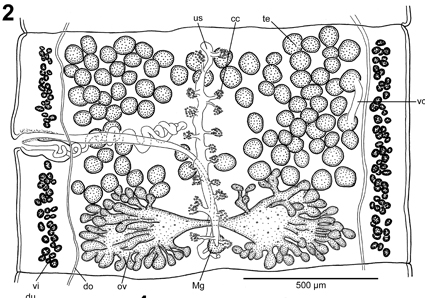Abstract
A new species of the little-known genus Australotaenia de Chambrier & de Chambrier, 2010 is described from Ranoidea australis (Gray) (Anura: Hylidae), commonly known as the giant frog, northern snapping frog or round frog and which is a burrowing frog species native to Australia. Australotaenia hobbsi n. sp. is the fourth species of the genus, but the first taxon found in a burrowing frog and in northern Australia. The other species were found in Australian tree frogs (Litoria spp.) in southwestern and southeastern Australia, and in the homalopsid snake Enhydris enhydris (Schneider) in Cambodia. Australotaenia hobbsi n. sp. differs from its congeners (i) by the wider strobila (maximum body width 1,750 µm versus < 930 µm), scolex (570 µm versus < 390 µm) and suckers (diameter 215–230 µm versus < 140 µm); (ii) by the smaller relative size of the cirrus sac (12–15% of proglottid width versus 17–33%); (iii) by the absence of a vaginal sphincter (present in the other three species); (iv) different arrangement of the inner longitudinal musculature, which consists of a few individual muscle fibres (in contrast to the fibres grouped in bundles in other species). Australotaenia species and Pangasiocestus romani Scholz & de Chambrier, 2012 from the spot pangasius Pangasius lernaudii Boucourt, both of the subfamily Acanthotaeniinae, are unique among proteocephalids in terms of intermediate uterine development, with a high concentration of chromophilic cells around the tip of the lateral uterine diverticula.
References
- Barker, J., Grigg, G.C. & Tyler, M.J. (1995) A Field Guide to Australian Frogs. Surrey Beatty & Sons, Chipping Norton, New South Wales, 407 pp.
- Barton, D.P. (1994) A checklist of helminth parasites of Australian Amphibia. Records of the South Australian Museum, 27, 13–30.
- de Chambrier, A. (2001) A new tapeworm from the Amazon, Amazotaenia yvettae n. gen., n. sp. (Eucestoda: Proteocephalidea) from the siluriform fishes Brachyplatystoma filamentosum and B. vaillanti (Pimelodidae). Revue Suisse de Zoologie, 108, 303–316. https://doi.org/10.5962/bhl.part.79632
- de Chambrier, A. (2004) Redescription of Ophiotaenia hylae Johnston, 1912 (Eucestoda: Proteocephalidea), parasite of Litoria aurea (Amphibia: Hylidae) from Australia. Revue Suisse de Zoologie, 111, 371–380. https://doi.org/10.5962/bhl.part.80243
- de Chambrier, A., Binh, T.T. & Scholz, T. (2012) Ophiotaenia bungari n. sp. (Cestoda), a parasite of Bungarus fasciatus (Schneider) (Ophidia: Elapidae) from Vietnam, with comments on relative ovarian size as a new and potentially useful diagnostic character for proteocephalidean tapeworms. Systematic Parasitology, 81, 39–50. https://doi.org/10.1007/s11230-011-9320-0
- de Chambrier, A., Brabec, J. & Scholz, T. (2020) Molecular data reveal unexpected species diversity of tapeworms of Australasian reptiles: revision of Kapsulotaenia (Cestoda: Proteocephalidae). Zootaxa, 4869 (4), 529–561. https://doi.org/10.11646/zootaxa.4869.4.4
- de Chambrier, A., Brabec, J., Tran, B.T. & Scholz, T. (2019) A morphological and molecular study of Acanthotaenia von Linstow, 1903 (Cestoda: Proteocephalidae), parasites of monitors (Varanus spp.): redescription of the type species, description of a new species from Vietnam and phylogenetic interrelationships. Parasitology Research, 118, 1761–1783. https://doi.org/10.1007/s00436-019-06326-6
- de Chambrier, A. & Scholz, T. (2012) A new species of Australotaenia (Cestoda: Proteocephalidea), from a snake in Cambodia: host switching or postcyclic parasitism in a distant region? Folia Parasitologica, 59, 279–286. https://doi.org/10.1007/s11230-011-9320-0
- de Chambrier, A., Waeschenbach, A., Fisseha, M., Scholz, T. & Mariaux, J. (2015) A large 28S rDNA-based phylogeny confirms the limitations of established morphological characters for classification of proteocephalidean tapeworms (Platyhelminthes, Cestoda). ZooKeys, 500, 25–59. https://doi.org/10.3897/zookeys.500.9360
- de Chambrier, A., Zehnder, M.P., Vaucher, C. & Mariaux, J. (2004) The evolution of the Proteocephalidea (Platyhelminthes, Eucestoda) based on an enlarged molecular phylogeny, with comments on their uterine development. Systematic Parasitology, 57, 159–171. https://doi.org/10.1023/B:SYPA.0000019083.26876.34
- de Chambrier, S. & de Chambrier, A. (2010) Two new genera and two new species of proteocephalidean tapeworms (Eucestoda) from reptiles and amphibians in Australia. Folia Parasitologica, 57, 263–279. https://doi.org/10.14411/fp.2010.033
- Cogger, H.G. (2014) Reptiles and Amphibians of Australia. 7th Edition. CSIRO Publishing, Collingwood, xxx + 1033 pp. https://doi.org/10.1071/9780643109773
- Gibson, D.I., Bray, R.A. & Harris, E.A. (Compilers) (2005) Host-Parasite Database of the Natural History Museum. London. Available from: http://www.nhm.ac.uk/research-curation/scientific-resources/taxonomy-systematics/host-parasites/ (accessed 2 April 2024)
- Johnston, H. (1912) Notes of some Entozoa. Proceedings of the Royal Society of Queensland, 24, 63–91. https://doi.org/10.5962/p.35038
- Jones, M.K. & Delvinquier, B.L.J. (1991) Nematotaeniid cestodes from Australian amphibians. Memoirs of the Queensland Museum, Brisbane, 30, 492.


